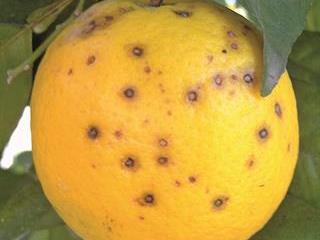
Due to its height and density, a citrus tree is one of the most difficult trees to protect from pests and diseases by means of spray application. South African citrus producers use intensive fungicide spray programmes to control citrus black spot (CBS) in compliance with the zero-tolerance approach to the disease in fruit exported to the EU.
Through years of research at Citrus Research International (CRI) at Stellenbosch University’s department of plant pathology, Dr Tian Schutte and several of his colleagues have developed spraying programmes to optimise CBS control. To achieve the desired results, the correct quantity of fungicide must be uniformly distributed on all target surfaces, including the tree’s fruit and leaves.
“Tree canopy management, sprayer set-up and calibration must be managed carefully,” says Gideon van Zyl, spray technology researcher at CRI. “There should be no spray drift or run-off that leads to environmental pollution and wasted product. A fungicide is only as effective as its application.” For effective CBS prevention, says Van Zyl, all factors influencing spray application should be thoroughly understood.
Farmers should prune trees correctly to enable the spray to penetrate the canopy. Thereafter, a suitable sprayer must be chosen, and the correct power take-off (PTO)speed, tractor speed, calibration, spraying pressure and nozzle selection used. All these affect the spray plume and spraying volume.
How to manage the canopy
Citrus trees must be ‘spray-friendly’. Dense canopy walls tend to shield or shingle as the sprayer passes through the row, reducing spray penetration, coverage and deposition on the inner canopy leaves and fruit, and aggravating run-off on the outer canopy leaf wall.
Prune to ensure adequate aeration of the canopy; this will improve spray penetration, fruit rind integrity and fruit set and quality. Prune small windows at the top, middle and bottom on either side of the canopy, and remove dead branches and twigs.
Manage tree height to match the height profile of the sprayer. This is variety-cultivar dependent; for pruning guidelines, visit CRI’s website: www.citrusres.com.
Sprayer type
“Because citrus trees are tall, dense and difficult to spray effectively, most producers use either tower or high-profile sprayers,” Van Zyl explains. “Low profile fan sprayers are less suitable, and often don’t reach the tree tops.”
Spray machines in South Africa vary in air volume and speed output, so selection of the correct sprayer can be difficult. A sprayer must produce an adequate airflow to carry the spray plume into the canopy at an air speed that will not blow the spray plume through and out of the canopy, increasing spray drift.
Preparation
Sprayer maintenance and calibration before the spraying season is crucial. To identify potential problems, fill one-third of the spray tank volume with clean water and pressurise the sprayer. Pay attention to the following:
- Tank volume: To prevent under- or over-dosing when agrochemicals are mixed in the tank, establish whether the tank volume meter is accurate. Use a flow meter and recalibrate the tank volume indicator as needed. Open and close all taps to test for leaks.
- Pump, filter and diaphragm: If clogged, these will impair the flow of the spray mixture to the nozzles. The incorrect flow will give an inaccurate spray volume, and may influence the concentration of a spray mixture with a granular formulation. Check, clean or replace the pump filter and diaphragm periodically. Clean the pump by regularly pumping clean water through the system. Check the pump oil regularly and replace it as necessary. The pump should deliver 20% to 30% more than the flow rate needed for the desired spray volume. Do not use maximum pump capacity. Conversely, inadequate pump capacity can impair tank agitation and volume delivery.
- Pipes: Leaking pipes will lead to inadequate pressure, lost spray mixture and an impaired nozzle flow rate, reducing the spray volume. Check for leaks and cracks and that the pipes are properly attached to the sprayer and tractor control valve.
- Oscillating arms: Lubricate the sprayer’s oscillating arms or booms. Check them for irregularities and impairment of function that will affect spray coverage and canopy penetration. The optimal oscillation rate is between 70 cycles/ min to 75 cycles/min.
- Fan: Check for chipped or damaged fan blades; unbalanced fans usually indicate dirt or damage. Replace cracked fan blades that can break off and damage the spraying machine or hurt the operator. The fan intake port must be free of debris such as leaves, mud, twigs and birds’ nests.Blocked intakes can put unnecessary stress on the PTO, affecting the volume and speed of the air supplied to the spray tower and influencing its distribution and carrying capacity. This will make the spray less uniform.
- Tower: Check the tower for cracks and holes. Air escaping from the tower will reduce the air pressure, volume and speed. This will in turn impair the spray plume’s carrying and distribution capacity.
- Pressure gauge: The wrong pressure will result in the wrong spray volume. Use a new gauge to evaluate the pressure and the pressure gauge’s accuracy.
- Tank agitator(s): To save time and cost, farmers usually put different chemicals, such as contact, systemic and wetting chemicals, into one spray tank for different diseases or pests. “These chemicals must be compatible, well-mixed and continuously agitated,” says Van Zyl. The larger the tank, the higher the rate of agitation required. Depending on the constituents and tank size, it may take up to 15 minutes to achieve a uniform mixture.
Poor agitation leads to non-uniform distribution of the active ingredients, resulting in under- or over-application. This can lead to treatment failure, phytotoxicity, excessive residue and possible resistance build-up.
Take the following steps:
- Wash the tank thoroughly with clean water;
- If necessary, use a tank cleaning chemical;
- Attach the tank to the sprayer frame properly;
- Check the tank for cracks and holes;
- Check the propeller blades, shaft connections/glands and drive belt;
- Although the hydraulic returns/jets should be sufficient to agitate the entire tank, consider whether the pump can handle the agitation when spraying at a high volume.
Spray nozzles
SA farmers usually spray at pressures ranging from 10bar to 30bar. This increases the nozzle wear rate, decreasing the nozzle’s lifetime. “Farmers should use nozzles made from higher quality and harder material such as ceramic, instead of brass,” says Van Zyl.
Ceramic is less prone to weathering, especially when an abrasive fungicide is continually used without replacing the nozzles. Worn, enlarged or distorted nozzles will produce larger spray droplets and increase the flow rate, resulting in over-application, runoff, poor deposition uniformity and quantity, and increasing environmental pollution.
A nozzle must be replaced when it is worn or has a distorted orifice. The lifespan of a nozzle depends on the material it is made from and the volume of spray passing through it. It is good practice to replace nozzles two to four times per season.
Leaking nozzles waste spray ingredients. The sprayer will not pressurise properly, affecting flow rate and droplet formation
Take the following steps:
- Fit nozzles correctly according to the predetermined setup;
- Base nozzle layout on delivery requirements; – Never use discs and cores (whirlers) of different materials;
- Ensure that the disc and the core are not installed backwards. Replace the nozzle seals regularly;
- Never over-tighten nozzle caps;
- Ensure that the spray plumes overlap in the spray pattern before reaching the crop canopy;
- Ensure that foliage intercepts the spray plume, especially at the top and bottom of the canopy, to reduce off-target drift.
Dirty application water, debris or undissolved chemicals clog nozzles, affecting the spray pattern, the spray volume and the lifetime of the nozzle. This can also lead to inadequate coverage, under-application and treatment failure. Use a nylon brush or compressed air to clean nozzle filters.
Never use wire, toothpicks or sharp objects, especially with ceramic nozzles. Determining the nozzle flow rate is tedious but very important. On a 10 000l/ha spray, a 10% deviation from the correct flow rate will result in over-application or under-application of 1 000l/ha.
To accurately determine the nozzle flow rate, measure the flow rates of individual nozzles over one minute; cover the nozzles with a pipe and measure the flow into a bucket. Alternatively, use a flow meter. For a good estimation, measure the tank volume sprayed in five minutes. If the difference between nozzles exceeds 10%, replace the nozzles.
To help the spray operator identify faulty nozzles, number the nozzle positions on the spray tower so that they are visible from the tractor cab.
Correct PTO speed
The incorrect PTO speed decreases the pump’s performance and reduces the sprayer’s lifetime. Use a calibrated tachometer (rev-counter) to accurately measure the PTO’s rotational speed and mark this on the tractor’s rpm gauge (this may not always be accurate.) Correct PTO connection and belt tension is essential for optimal energy transfer.
Lubricate and firmly attach the PTO shaft. Check the belt tension and PTO connection. Universal joints must be properly attached and a PTO cover should be present.
Tractor speed
Tractor speed changes as tyres wear and when tyres or air pressure are altered. Dry or wet soil may also affect ground speed.
Tractor speed must be precisely measurable, as it plays an important part in determining spray volume and application effectiveness; this in turn directly influences canopy penetration, deposition and uniformity. With the sprayer attached to the tractor and the tank one-third full of water at the recommended PTO speed (540r/min), determine the tractor speed by driving several times over a measured, level test strip of either 50m or 100m. Record the driving time in seconds in all low gears used for spraying.
Reach the desired speed before entering the test strip and maintain it throughout the test run. To calculate the tractor speed, multiply the test strip length by the number of runs, and divide the total distance by the total time for all runs. Multiply this number by 3,6 (a constant factor) to calculate the ground speed in km/h.
The slower the tractor speed, the better the canopy penetration, uniformity and deposition of chemical on the tree surfaces.
“The recommended standard in the citrus industry is a tractor speed of 2,4km/h. At any higher speed, follow the principles of precision farming and precision spray application. A farmer should establish which combination of factors works best for his operation.”
Van Zyl advises farmers to first get the basics right. This includes understanding the principles of canopy management, spray application, spray equipment maintenance, and timely calibration. “Then you can optimise your methods by reducing application cost, time efficiency and loss of chemicals.”
Email Gideon van Zyl at [email protected] or Dr Tian Schutte at [email protected].













